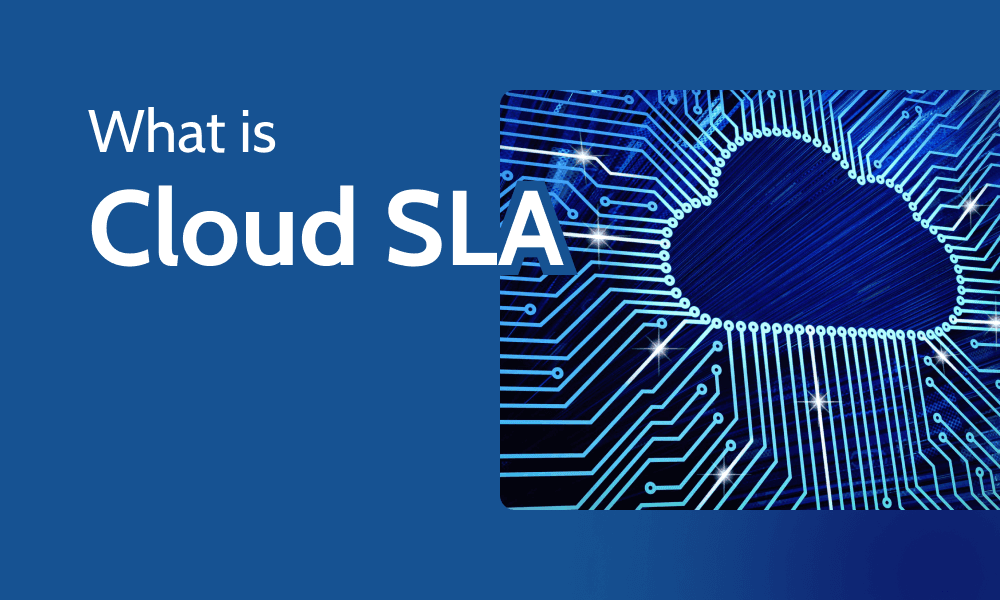When people pay for a good or service, they generally want some form of quality assurance for the product they receive. User reviews, recommendations from friends and personal experiences can offer some degree of confidence, but a documented promise of quality from the company itself offers the most assurance.
Cloud computing platforms offer an assurance of quality through a document called a service-level agreement (SLA). Having said that, an SLA is not just a document that guarantees quality. Read on as we explore cloud SLA while discussing its key components, metrics, importance and more.
Cloud SLA Meaning
Cloud SLA stands for “cloud service-level agreement.” It is a document that outlines the minimum level of service that a cloud provider agrees to deliver to the user. You can think of it as a contract between a cloud provider and its users, indicating the typical service quality that they will experience.
Beyond demonstrating the expected quality levels, cloud SLAs highlight the service-level monitoring parameters, penalties for failing to meet the expected service levels, and each party’s responsibilities.
Why Do SLAs Matter?
SLAs matter because they clearly indicate the prospects of using a service before a user commits. In addition to clarifying the roles of a user and cloud provider in upholding the service quality, they also define the metrics for keeping each party accountable.
An SLA protects cloud providers and users in case of litigations by serving as a legal reference for accountability. Furthermore, as cloud providers strive to meet and improve the service-level benchmarks highlighted in their SLAs, they end up enhancing the customer’s experience and satisfaction.
Service-Level Agreement Types
Depending on the primary factors related to the itemized services, an SLA can be customer-level or service-level. It can also be multi-level to allow for varying conditions.
Customer-level SLA: A customer-level SLA is designed for a specific customer. It specifies the services that this customer uses, and it’s a top option when the client’s service requirements are markedly unique compared to other client.
Service-level SLA: A service-level SLA is more general and easier to manage. It includes the standards for one or more services that a service provider delivers to multiple customers.
Multi-level SLA: By combining the features of other SLA types, a multi-level SLA leaves room for various conditions, such as different service classes and multiple clients.
Examples of Service-Level Agreement Metrics
Service-level agreement metrics are the quantifiable benchmarks for assessing an SLA. They include uptime, data durability, recovery time objective (RTO) and recovery point objective (RPO).
Uptime
Uptime, also called “service availability,” is the most crucial SLA metric. It offers a guarantee of how long the cloud provider’s services will be operational and accessible over a given time period, and it is represented by a percentage. Typically, cloud providers guarantee uptimes of at least 99%, with some going as high as 99.99% on some services.
Response Time
Response times measure the time between user inputs and system feedback. This metric consolidates the response times from multiple units and finds an average. For instance, if system A responds in 3 seconds, system B responds in 5 seconds and system C responds in 1 second, then the given response time would be 3 seconds.
Security Arrangements
This metric represents active security measures that the provider takes to ensure security. Typically, security practices are not quantifiable. However, when trying to measure controllable security metrics, we can use the frequency of patches, vulnerability assessments and antivirus updates.
Error Rate
Error rates are a metric that allows the customer to measure how often the provider falls short of its promised service levels. It offers a way to keep the provider accountable and can entail figures such as the number of API errors over a given period.
First-Contact Resolution
First-contact resolution shows the rate or percentage of service disruptions that are resolved when the customer first contacts the provider. Higher first-contact resolutions show high efficiency from the provider’s customer support team.
Data Durability
Data durability is an assurance of data integrity, persistence and accessibility over time. It is usually stated as a percentage, which represents the amount of data that will be preserved over any storage period. Among the top cloud providers, you’ll typically find data durabilities of around 99.999999999%.
Recovery Time Objective
Recovery Time Objective (RTO) measures how long it takes for systems to resume normal operations after a service failure. It defines the maximum acceptable downtime and can be measured in various units, such as seconds, minutes and hours.
RTO values vary greatly across cloud providers and services. They depend on the system or application’s importance, with the most critical operations having the shortest RTOs.
Recovery Point Objective
Recovery Point Objective (RPO) is the time point from which data must be restored. It is a measurement of tolerable data loss represented in units of time. Together, RTO and RPO are the most important performance metrics of a disaster recovery plan. Furthermore, you can expect the most critical applications or systems to have the lowest RPOs.
Key Components of Cloud Service-Level Agreements
Some key components of cloud SLAs include penalties, disaster recovery processes, descriptions of services, exclusions and more.
- Penalties: This describes the consequences that either party will face if they fall short of their SLA responsibilities. Typically, penalties are financial — such as a tiered service credit plan or fee reduction — but there are also non-financial penalties, like license extensions.
- Disaster recovery process: This outlines the steps to take when there’s a cloud disaster. It contains information on how to get up and running again, along with recovery times and other factors.
- Description of services: This crucial part of a cloud SLA defines all the services covered, plus specific details like maintenance schedules.
- Exclusions: This itemizes any details that the SLA doesn’t cover.
- Service-level objective: This describes the metrics that the cloud vendor is expected to meet to ensure service quality. It defines details such as uptime and throughput.
- Termination process: The SLA must contain information about the notice periods required for service termination. It will also discuss the conditions that may warrant service termination.
- Renewal conditions: In addition to the termination process, an SLA can also include renewal conditions such as penalty updates and the renegotiation of service-level objectives.
- Signatures: An SLA will contain signatures from the cloud provider and the client.
- Reviews and updates: To optimize an SLA to align with the evolving needs of the client and provider, regular reviews and updates are important. An SLA will include the review and update procedures, including update frequency and performance assessment metrics.
- Responsibilities: This describes what tasks both sides must fulfill when it comes to service delivery, escalation and communication.
- SLA summary: This gives an overview of the agreement’s major details, including dates, cloud provider details and customer information.
- Service summary: This outlines the entire SLA. You may also find a summary of the services covered, including the uptimes and types of services.
What Happens If an SLA Isn’t Upheld?
The contract often states the consequences of failing to meet the SLA conditions. These include penalties like free service extensions, service credits and fees.
While cloud providers typically incur penalties when an SLA isn’t upheld, users can also face consequences. For instance, if a user fails to comply with the usage policies or payment terms, they may be excluded from the SLA’s protection, incur extra charges or experience poor service.
What Does an SLA Lifecycle Look Like?
An SLA lifecycle starts with the customer getting in contact with their preferred cloud service provider. Following this, both parties will analyze their requirements and resources to create the initial drafts.

Reviewing and updating your SLA routinely ensures that it stays relevant.
While preparing to finalize the terms, both parties will go over the drafted SLA and suggest any modifications before passing it on for legal reviews. Once the checks and modifications are made, the client and provider will finalize the SLA. After that, they will move on to the implementation phase.
In this phase, the SLA is now operational. The provider will start offering services based on the agreed-upon service levels while monitoring the defined cloud SLA metrics and reporting to ensure transparency. Whenever there’s a breach of terms on either side, penalties are incurred based on the SLA. If warranted, the SLA can be terminated.
The implementation phase is sandwiched between routine reviews and updates. This ongoing process features service modifications, service tracking, client-provider feedback and renegotiations.
SLA Benefits
An SLA offers a range of benefits. These include enhancing customer experiences, protecting the interests of cloud service providers and clients, minimizing risks and ensuring effective communication.
- Enhanced customer experiences: Service-level agreements motivate cloud service providers to meet and exceed the specified service levels to maintain customer satisfaction.
- Protection of interests: In case of disagreements, SLAs serve as a point of reference for both parties, ensuring that no one is at an unfair disadvantage.
- Risk minimization: Cloud providers must actively seek out and resolve any threats that could prevent them from delivering the service levels outlined in the SLA. As a result, they will minimize risks and improve reliability.
- Efficient dispute resolution: An SLA outlines the procedures for handling service-related disputes. For this reason, dispute resolutions are typically straightforward.
- Accountability: An SLA will clearly state the responsibilities of both the client and the cloud provider. Therefore, everyone should know their roles and obligations.
SLA Challenges
While generally beneficial, an SLA can become challenging if it is unclear, unfairly skewed or unrealistic.
- Unclear conditions: Verbose SLAs with nonspecific wordings — such as unquantifiable metrics — pose a translation problem, leaving loopholes that allow for unfair advantages.
- Skewed terms: If an SLA’s penalties and benefits are unfairly skewed, either to the cloud provider or the user, it can be difficult to strike a deal.
- Unrealistic conditions: When negotiating an SLA, if the customer asks for impossible service levels (such as 100% uptime), reaching an agreement will be challenging.
- Nonspecific service coverage: If the exact services that the SLA covers are not stated in the contract, there will be disputes.
- Obsession with metrics: If the cloud provider focuses more on hitting metric goals than actual customer satisfaction, operations may become stiff. This may cause customer experiences to take a back seat.
Final Thoughts: Cloud Service-Level Agreements
An SLA is a contract that binds cloud providers and customers to their respective roles, which keeps things running smoothly. It features the responsibilities of both sides, as well as any penalties when they falter, ensuring accountability.
In your experience, which SLA component do you think is the most important? Besides service credits, fines and extended service access, which SLA penalty do you come across frequently? Let us know your thoughts in the comments, and as always, thank you for reading.
FAQ: SLA for Cloud Services
-
SLA stands for service-level agreement. It is a contract between a client and service provider detailing the expected level of service and other terms that ensure quality service delivery.
-
The three types of SLA are service-level, customer-level and multi-level.
-
An example of an SLA is the Amazon S3 SLA, which offers service credits when the monthly uptime percentage falls below the stated limits.











